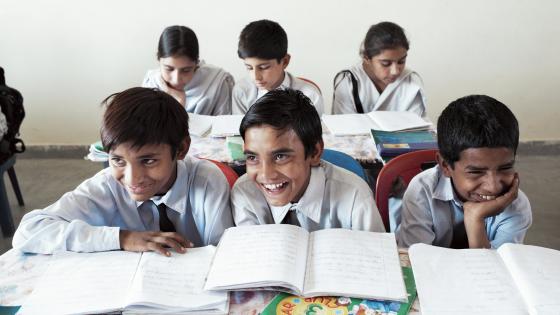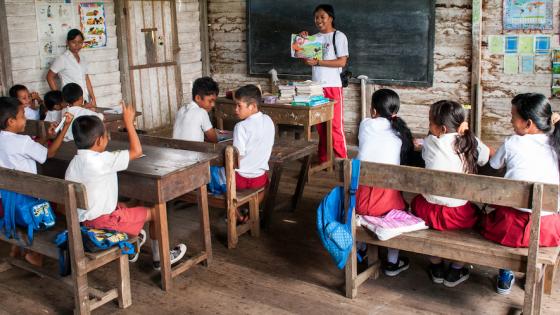In the past, policymakers worried that there were not enough schools for children in low- and middle-income countries. But today, millions of children in these countries live in villages or neighbourhoods where they can choose from multiple public or private schools. Figure 1, for instance, shows a typical village in the Learning and Educational Achievement in Pakistan Schools (LEAPS) study. The village takes 20 minutes to cross on foot, but has five private and two public schools. The average village in the LEAPS sample has 7.3 schools, and 60 to 70% of the rural population in Punjab (Pakistan’s largest province) lives in such environments. If we include cities, that fraction rises to more than 90%.
Figure 1 A typical village in rural Pakistan has multiple schools for parents to choose from

Notes: Private schools are shown with a $ sign and public schools with a house and flag. The village shown is in the Learning and Educational Achievement in Pakistan Schools or LEAPS study.
That is a big deal for public policy, which has historically failed to account for the relationship between public policy and the private sector in education.
To see why, note that private schools in Pakistan, like in many other countries, are financed almost entirely through school fees, which parents must be willing to pay. Therefore, when public schools improve, private schools must respond, or face the risk of losing valuable revenue as children opt to attend improved public schools. Thus, understanding the total impact of any programme - even those targeted purely to public schools - requires considering its effect on all other schools in the market, not just on the school where the intervention was implemented, as accounting for the total effects can lead to very different conclusions about effectiveness. Our new paper (Andrabi et al. 2023) measures the effect of a public school grants programme in rural Pakistan and estimates the ‘education multiplier’ for the effect of public funding on private sector school quality.
The Evaluation
Our evaluation has three key features: the environment, the intervention, and the data.
- Environment: We worked in 80 villages with closed education markets, where 90% of the children in the village attend schools in the village, and 90% of the enrolment in the schools comes from the village itself. Closed markets allow us to trace the full impact of public school improvements on other schools without getting into tricky questions of determining which private schools compete with treated public schools.
- Intervention: Our intervention was a grants programme where money was given to public schools for necessary investments determined by a newly constituted school council in collaboration with an NGO. The programme was allocated to randomly selected villages, and the research team had zero contact with the government, both in the targeting of schools within villages and the implementation of the scheme, allowing us to identify the effects of the policy as it would be implemented by the government in practice.
- Data: We collected data from all schools in these villages between 2003 and 2011 as part of the LEAPS study. We tested more than 70,000 children, interviewed more than 4,000 school-owners and teachers, and collected detailed information on the households of the tested children. We also gathered information about which schools exited and entered the market over these eight years and how their enrolments changed over this period.
Five years after the programme started in 2006, public schools in treated villages had received an additional PKR 492,020 in funding compared to those in control villages. This amount translates into a 42% increase over the funding that control schools received in this period and 29% of median annual public-school expenditures (inclusive of teacher salaries). Consistent with the new guidelines, we also find that the composition of school councils became more socioeconomically inclusive and representative of the parent body, and the number of school council meetings increased.
Test scores increase in public and private schools
We then show that the programme causally increased aggregate test scores in treated villages by 0.2 standard deviations. This aggregate increase reflects, first, an increase in test scores of 0.2 standard deviations among public schools. Strikingly, through the education multiplier, it also reflects an increase in test scores of 0.2 standard deviations among private schools. Furthermore, among private schools, test score improvements were higher in schools that faced stronger competitive pressures. Consistent with models of ‘horizontal differentiation’, private schools located closer to public schools saw larger test score increases. Consistent with models of ‘vertical differentiation,” private schools located in villages with higher-quality public schools at the beginning of the programme improved the most, even though there was no heterogeneity in the impact of the treatment on public schools themselves by baseline test scores.
Private school fees and their entry or exit into the schooling market are not affected
Interestingly, we do not find evidence of a treatment effect on private school fees, exits (or entries) or market shares - by 2011, the market share of private schools was the same in treatment and control villages. The fact that market share did not change does not mean that parents do not respond to or observe improvements in school quality. Rather, enrolment shares in 2011 are an equilibrium outcome following quality changes in both sectors.
Cost-effectiveness
Using standard methods from the literature (Dhaliwal et al. 2013), we then show that the intervention increased test scores in public schools by 1.18 standard deviations for every US$100 in additional spending. But once we factor in improvement in private schools as well, cost-effectiveness increases by 85% to 2.18 standard deviations for every $100 in additional public funding, putting the programme among a small group of highly cost-effective interventions (see Evans and Yuan 2022). Finally, the education multiplier also had fundamental implications for how programmes should be targeted. We show that regardless of whether the government is interested in maximising test score gains from the programme or is interested both in equity and gains, accounting for the education multiplier changes the optimal geographical targeting and distribution of grants across villages.
Conclusion
Our first main result, that grants to public schools increased test scores, contrasts with an earlier literature where null effects were more common (e.g. Das et. al. 2013, Mbiti et. al. 2019). We may now need to move beyond such ‘grant pessimism’ precisely because we have learned from the previous failures. In contrast to previous grants in India and Zambia, which were offset by parents because they were small, the grants here were much larger and could be used for infrastructure improvements (Das et al. 2013). Indeed, grant size and test score improvements are positively correlated in this programme.
In addition, the schools could use the grants to hire teachers on temporary contracts. Again, this policy reflected what we had learned from prior research, which has consistently shown that teachers hired on temporary contracts may be more effective because they face stronger career incentives (Duflo et al. 2015, Muralidharan and Sundararaman 2013, Bau and Das 2020).
Finally, to avoid the problems of centrally mandated expenditures that are not responsive to local needs as well as potential misuse, schools worked with a reputed NGO and a reconstituted school council to determine investment priorities that were then funded through the grant.
Beyond showing that public school grants can increase test scores, this study demonstrates the existence of a large education multiplier from the public to the private sector. Hundreds of millions of children live in neighbourhoods/villages with substantial school choice, and many of the schools that they can choose from are private schools that survive on school fees. In this highly interconnected world, the idea that there are `programmes for public schools’ and `programmes for private schools’ and that the two can be kept separate is no longer tenable. Failing to account for the effect of public sector interventions on the private sector - ex-ante in the design of the programme and ex-post in its evaluation – leads to less effective interventions and inaccurate evaluations. In our case, restricting the focus to public schools would have led to an entirely different estimate of the programme’s cost effectiveness.
While we show that taking the private sector into account is crucial, spillovers on private schools need not always be positive. Dinerstein and Smith (2021) find that in New York City a public-school improvement programme led to children leaving private schools, and these schools then shutting down. In the Dominican Republic, Nielson et al. (2020) show that a huge school construction programme led to the closure of some private schools, but with quality improvements among the survivors. But across all these studies, the clear message is that the days when public school programmes would have effects only on public schools are over. We need to think of the full schooling environment and not just the part in which we have intervened.
Editors' note: This column first appeared on VoxDev.
References
Andrabi, T, N Bau, J Das, N Karachiwalla, and A I Khwaja (2023), “Crowding in Private Quality: The Equilibrium Effects of Public Spending in Education”, NBER Working Paper 30929.
Bau, N and J Das (2020), “Teacher Value-Added in a Low-Income Country", American Economic Journal: Economic Policy 12(1): 62-96.
Das, J, S Dercon, J Habyarimana, P Krishnan, K Muralidharan, and V Sundararaman (2013), “School inputs, household substitution, and test scores", American Economic Journal: Applied Economics 5(2): 29-57.
Dhaliwal, I, E Duflo, R Glennerster, and C Tulloch (2013), “Comparative cost-effectiveness analysis to inform policy in developing countries: a general framework with applications for education", Education Policy in Developing Countries17: 285-338.
Dinerstein, M and T D Smith (2021), “Quantifying the supply response of private schools to public policies", American Economic Review 111(10): 3376-3417.
Duflo, E, P Dupas, and M Kremer (2015), “School governance, teacher incentives, and pupil-teacher ratios: Experimental evidence from Kenyan primary schools", Journal of Public Economics 123: 92-110.
Evans, D K and F Yuan (2022), “How big are effect sizes in international education studies?", Educational Evaluation and Policy Analysis 44(3): 532-540.
Muralidharan, K and V Sundararaman (2013), “Contract teachers: Experimental evidence from India", NBER Working Paper 19440.
Mbiti, I, K Muralidharan, M Romero, Y Schipper, C Manda, and R Rajani. "Inputs, incentives, and complementarities in education: Experimental evidence from Tanzania." The Quarterly Journal of Economics 134, no. 3 (2019): 1627-1673.
Neilson, C, M Dinerstein, and S Otero (2020), “The Equilibrium Effects of Public Provision in Education Markets: Evidence from a Public School Expansion Policy", Working Paper.







